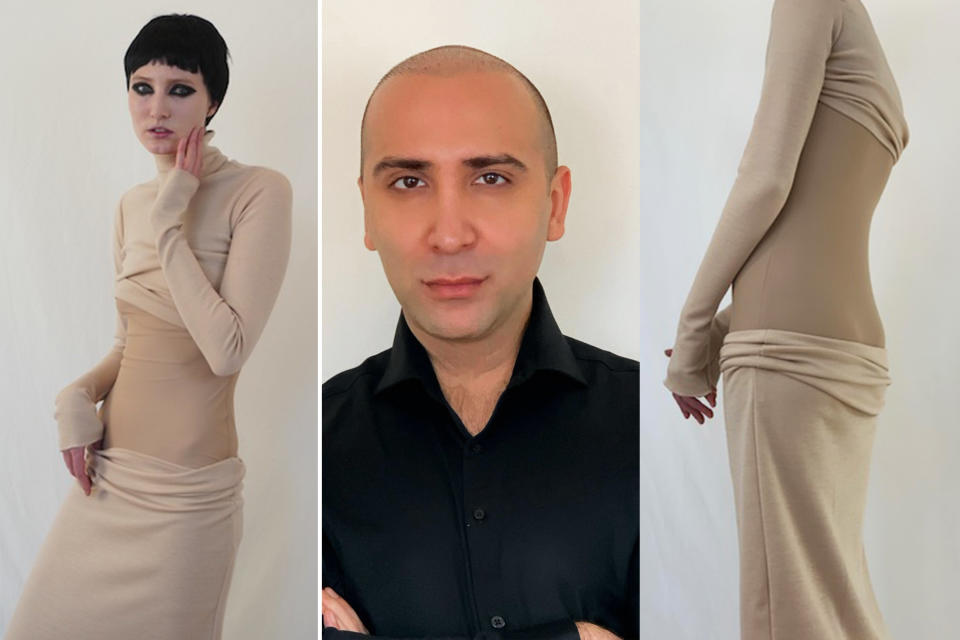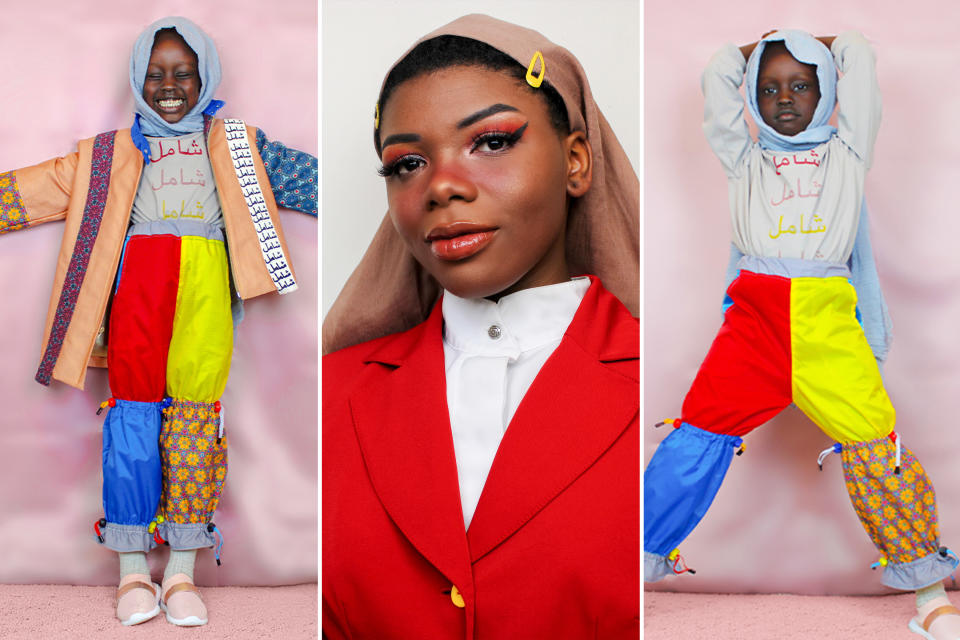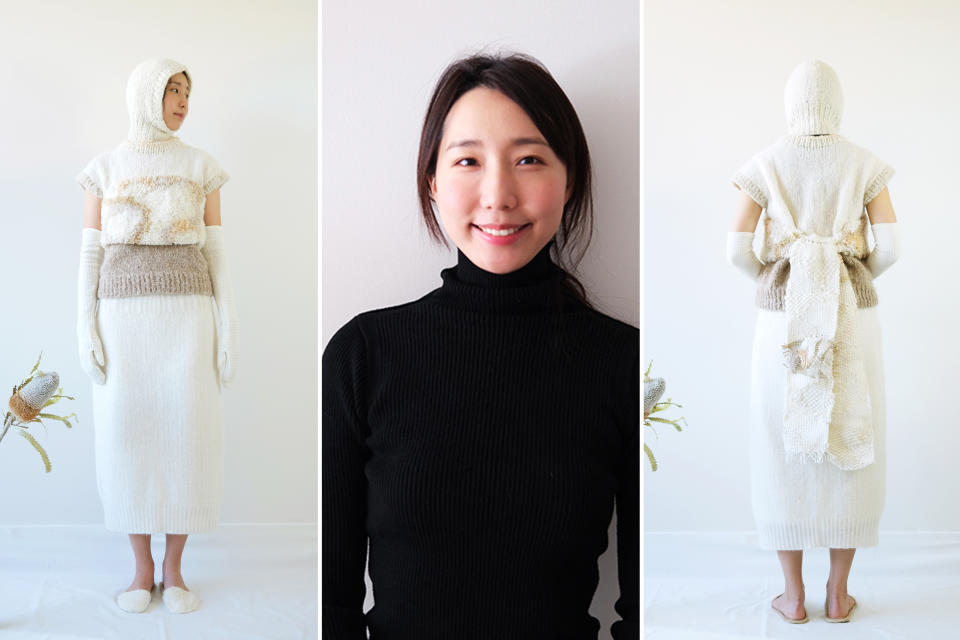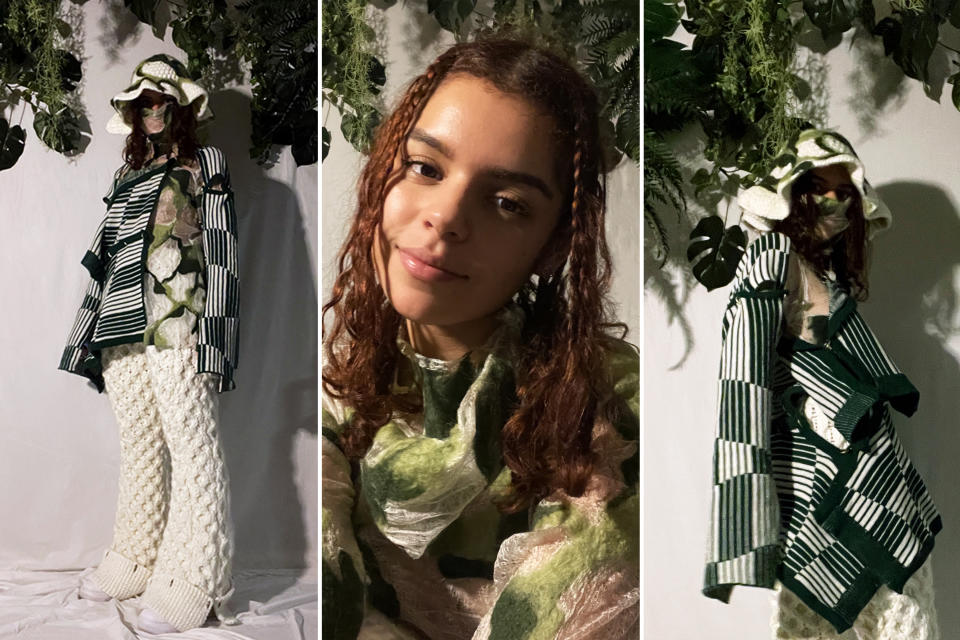Fashion Institute of Technology’s Thesis Collections: Inside the Class of 2021’s Designs

The Fashion Institute of Technology’s graduating fashion design students spent their entire senior year learning remotely due to the pandemic. This meant crafting their thesis collections — designs that are often seen as an entryway to getting a coveted design job or, in rare cases, a star-making order from an influential store — from their own homes.
With limited resources, students improvised by upcycling old or deadstock fabric and by cleverly constructing clothes on their living room floors.
More from WWD
Herein, WWD meets five members from FIT’s class of 2021 who explain the concepts and inspirations behind their thesis designs, as well as their hopes for the future.

Name: Abraham Azamy
Age: 26
Hometown: Mission Viejo, Calif.
Describe the concept behind your thesis collection: My concept is focused on capturing the playfulness of undressing and the subtle illusion of skin exposure. I find the irony in flaunting your body while being fully clothed to be mischievous yet seductive. My idea for this garment was based more on sex appeal as a suggestion rather than an obvious statement. The intention is to give the wearer the power to be provocative in a way that is subtle and refined.
Where have you been studying from while school is closed? Do you have plans to move after the pandemic? The transition from in-person to remote learning has been a blessing in disguise. I have been studying from my apartment in Brooklyn, N.Y. Once COVID-19 hit, I was fortunate enough to be able to convert my common area into a work studio, and invest in a commercial sewing machine outfitted with my own cutting table and desk. I felt my creativity flourish in this environment that I created for myself, which enabled me to design more freely.
How has the pandemic affected your design aesthetic or process and the outcome of your thesis collection? The forced isolation from the pandemic has allowed me to find my voice, effectively express my vision, and further my creativity. I had the opportunity to marinate in my ideas and to cement exactly what it is I’m offering to future employers. The catalyst for my creative process begins with an idea, concept, or character and once that is established, designing from there. Creating on my own during the pandemic narrowed my focus for the better and everything came together in an organic way.
Has the pandemic changed your outlook on the fashion industry? If so, how? We as creatives are responsible for cultivating new and effective methods for the production process, as well as the quantity of merchandise we spew out into the market. In the beginning of the pandemic, it became increasingly difficult to gain access to resources as a fashion student, which further solidified the concept of “less is more.”
Who do you hope is reading this and what is your message to them? I would hope a potential, future employer will see this and recognize my integrity and ability to design from a genuine and raw point of view.

Name: Hawwaa Ibrahim
Hometown: Mankato, Minn.
Age: 22
Describe the concept behind your thesis collection: Inspired by genderless fashion and art in the Islamic world, this collection offers clothing that is genderless and created for the parent and child to think freely about how they would like to express themselves now and in the future.
What techniques are you most proud of in your thesis collection? I created the prints used throughout my collection by taking items that I found in my house and putting them through a kaleidoscope effect to create geometric shapes that resembled what you might see in Islamic art. I also incorporated some embroidery to give the design some texture. I took the word “inclusive” and translated it into Arabic and machine-embroidered it on one of the jacket straps of my design.
What were some of the inspirations, concepts or important world events that helped lead your thesis work? I decided to challenge the idea of color being associated with gender and used a mix of shades and tones to create something that no one has seen yet. A lot of gender-inclusive or gender-neutral clothing we see nowadays has a tendency to be a bit bland when it comes to color.
How has the pandemic affected your design aesthetic or process and the outcome of your thesis collection? Throughout this pandemic, I was able to narrow down the things that are important to me in life and as I paid more attention to how people around the world treat each other, I found myself growing closer to my religion, my Islamic faith. I found a way to showcase something that’s fundamental in my life and heavily influences the way I live — so with gender identity, this also plays a role in how I choose to express myself. Contrary to popular belief, gender expression and religious identity are not mutually exclusive. I try to live in harmony with both.
Has the pandemic changed your outlook on the fashion industry? If so, how? The pandemic has drastically changed my outlook on the fashion industry. There has been a disregard for not only other people’s identities, but also with who is represented. I always knew this was happening, but the resurgence of the Black Lives Matter movement across the world last summer forced me to wake up. I saw how quickly people and companies within the fashion industry suddenly switched up to act like they’ve cared about Black and Indigenous people and people of color this whole time as they continue to profit off of them with no recognition and no respect. However, finally seeing other designers emerge and get the attention they deserve gave me some hope that the fashion industry is slowly moving in the right direction.
What do you hope to accomplish most in your career as a fashion designer? Children, even at their young ages, have opinions and beliefs, so I would like to provide them with options of expression. I hope to create children’s clothing that sparks conversation around how people consciously choose to express themselves with clothing and how it intertwines with other aspects of their life. Fashion is much more than nice pieces of clothing. It’s identity, it’s comfort, it’s its own language. I personally take my views on gender identity and my religious beliefs and let those things open up a world of possibilities in design.
What are your plans for after graduation? After graduation, I am hoping to work in children’s wear for two or three years to gain some experience. After that, I want to work full time for my own apparel and accessories brand, Because, which I started in 2019. My goal is to incorporate genderless children’s clothing into the mix!

Name: Saemi Jeon
Hometown: Incheon, South Korea
Age: 26
Describe the concept behind your thesis collection: My thesis collection is called “The Memory Vessel.” The concept comes from seeing Memor Studio’s artwork on Instagram around memory jugs. The origins of the memory jug are somewhat vague, but they were made as memorials for deceased loved ones.
What techniques are you most proud of in your thesis collection? I used a variety of techniques, including hand-knitting, knitting done on a Stoll machine, weaving and latch-hook skills. I enjoyed incorporating the techniques to achieve the final look, which came together quite naturally. I am most proud of my hand-knit work in the balaclava and sleeveless drop-shoulder sweater top, because it was my first time knitting an entire piece by hand.
What were some of the inspirations, concepts or important world events that helped lead your thesis work? After learning the concept of the memory jug, I asked myself; “if I were to make a memory jug, what memory would I put inside of it?” Many memories came into my mind. A dogwood flower. I was once gifted white dogwood flowers at my graduation. This flower is delicate, and soft. Even though I don’t have the flowers anymore, the memory of that day still warms my heart.
Where have you been studying from while school is closed? Do you have plans to move after the pandemic? I have been studying both at home in Korea and here in New York. I went back to Korea last semester and took classes at night and early morning, which was very tough. I came back to New York this semester and studied at home. I don’t have a plan to move back to Korea after the pandemic. I will remain in New York City.
How has the pandemic affected your design aesthetic or process and the outcome of your thesis collection? I had limited access to school where the knitting labs are. It would have been a much easier process to work in the labs and have face-to-face communication with professors and technicians. However, I was very touched by how hard everyone worked to make up for the limitations placed on the students.
Has the pandemic changed your outlook on the fashion industry? If so, how? The pandemic has lifted up the curtains on worldwide pollution. The Himalayan mountain tops came into view, wild animals appeared in city streets, the air was cleaner. Through this unexpected situation, we had an opportunity to take a step back and see what we could have. The fashion industry should shift to a more sustainable chain of production.
Name a trend you are ready to see take off and a trend you are ready to see finish: I would love to see timeless classic designs, based on comfort become the trend. Flashy, showy trends that are ever-changing from season to season is something I’m ready to see fade away.

Name: Yitao Li
Hometown: Taiyuan, China
Age: 22
Describe the concept behind your thesis collection: The inspiration for this collection was the idea of distortion. In the digital world, in which we find ourselves so completely ensconced, I am constantly confronted with distortion whether it’s associated with media, art, or people’s biased opinions. Many things we see on the internet are not real but filtered through other people’s lenses.
What techniques are you most proud of in your thesis collection? I tried creating distorted “floating plaids” on the body with multiple materials including horsehair and 3D-printing material. The plaid fabric manipulation was moved and reshaped on the body to show movement. I also combined the plaid pattern with lace to juxtapose sharpness with softness and create a romantic effect.
What were some of the inspirations, concepts or important world events that helped lead your thesis work? My interest was piqued in how images in the media were different from reality, how software like Photoshop and other image-editing apps could easily change the appearance of anything and deceive the viewer. The process started by using distorted filters on regular objects. The distortion filters were then applied to my designs and drapes to find new silhouettes and possibilities.
Has the pandemic changed your outlook on the fashion industry? If so, how? I believe after the pandemic hit the industry there have been some positive effects. People in this industry have been doing things the same way for hundreds of years and suddenly everyone was forced into adjusting. I was amazed at how the creativity from the industry evolved in a remote environment. The collections were even better than previous years. There was also a bigger audience on social media platforms and new talents are getting a lot more exposure.

Name: Gabriela Villatoro
Hometown: Miami
Age: 22
Describe the concept behind your thesis collection: Taken from the idea of upcycling, I wanted to make multifunctional garments. By showing the wearer how the same pieces can be used to create different looks, the wearer can “upcycle” the garments themselves and extend the product’s life cycle.
What techniques are you most proud of in your thesis collection? One of the best things about being in knitwear is being able to create your own fabric. All of the fabrics used in the garments were handmade or designed and programmed by me. I used hand-knitting, machine-knitting techniques and felting wool on sheer silk.
What were some of the inspirations, concepts or important world events that helped lead your thesis work? I wanted my collection to serve as a prototype solution for the overproduction of apparel materials in the fashion industry. If we create pieces that can be used multiple ways, ideally it would reduce the overall number of textiles and clothing being produced.
How has the pandemic affected your design aesthetic or process and the outcome of your thesis collection? I think the pandemic has really forced me to look within myself to be a solution-driven designer. In a classroom environment you can easily turn to your peers and ask for their help when you’re stuck or ask for their opinion. Although we still meet and see each other online, the distanced environment has highlighted our individual thinking.
Name a trend you are ready to see take off and a trend you are ready to see finish: I’ve seen things that have the feeling of being handmade become increasingly popular. I think because of the pandemic a lot of people had the time to start new hobbies and make whatever they want, which I think is great to see.
A trend I’m ready to see go is sweatpants. With the pandemic, and nowhere to go, they’re the most practical solution, but I look forward to the days when we will have somewhere to go.
What are your plans for after graduation? I want to start working in knitwear because there’s still a lot I can learn, and then hopefully use what I’ve learned to start my own brand of clothing.
Best of WWD
Sign up for WWD's Newsletter. For the latest news, follow us on Twitter, Facebook, and Instagram.